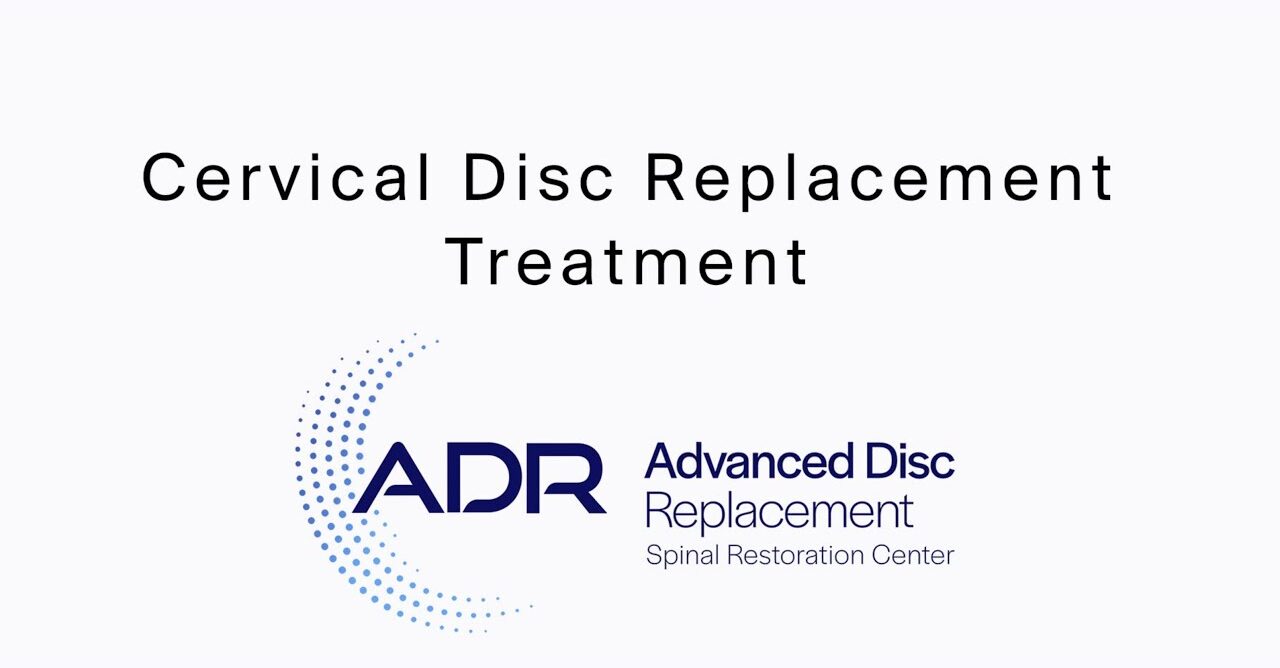

Cervical disc replacement is a surgical procedure to treat acute and chronic neck pain and stiffness with arm pain.
Cervical disc replacement surgery involves the removal of the diseased cervical disc and the placement of an artificial cervical disc in its place. The new, artificial cervical disc supports the cervical spine in the neck, but also allows the neck to bend, flex, and rotate.

What is Cervical Disc Replacement?
Cervical disc replacement is one of the two main surgical treatments for acute and chronic neck pain caused by degenerative disc disease. The other is spinal fusion. The natural cervical discs are incredible bits of anatomy, allowing the neck to move the relatively heavy head in any number of ways. However, this flexibility and support come at a cost: Over time, natural vertebral discs tend to wear out, causing pain and stiffness. When these symptoms become too much to bear, a spine surgeon performs a cervical disc replacement to remove all remnants of the diseased cervical disc and replace it with an artificial disc that closely mimics the actions of the natural disc. Unlike the natural cervical disc, artificial cervical discs do not wear out so easily.
What Does Cervical Disc Replacement Surgery Do?
Most patients choose cervical disc replacement surgery to relieve their neck pain, stiffness, and decreased range of motion. For many, this relief is enough. For those who want to know what cervical disc replacement surgery actually does, here are the most common benefits:
Cervical disc replacement relieves nerve compression.
The natural vertebral disc lies in a space between the spinal bones, also known as vertebral bones. In fact, the proper term for these structures is intervertebral discs. As the natural disc ages, it shrinks, becomes more brittle, and tends to leave its usual space between the spinal bones. The spine is a crowded space, however, with the spinal cord, nerve roots, and nerves occupying their own natural spaces. When a cervical disc presses on a nerve (nerve compression), it may cause pain. Removing the damaged cervical disc relieves nerve compression and pain.
Cervical disc replacement improves neck mobility.
One of the main reasons a young, healthy person can move their neck freely and painlessly is because of healthy cervical discs. Cervical discs provide a certain space between pairs of spinal bones so they can move as the person looks up, down, and side-to-side. Diseased discs tend to shrink and collapse, so the pair of spinal bones are closer together and cannot move as freely. A cervical disc replacement restores this space and restores a good deal of movement in the cervical spine, which reduces stiffness and increases neck mobility.
Cervical disc replacement decreases disease at other spine levels.
The spine is made up of many vertebral bones and discs, all working together to provide support and mobility. When one of these bones or discs is diseased, it can affect the bones and discs above and especially below it. A damaged disc causes stress and misalignment along the spine, which puts unusual and damaging strain on other vertebral discs. Thus, cervical disc replacement can improve the function of the spine as a whole by normalizing the biomechanics of the spine.

When is Cervical Disc Replacement Surgery Needed?
With few exceptions, most patients with cervical disc disease will receive non-surgical treatments before cervical disc replacement surgery. That is because many cases of acute cervical pain will resolve with conservative treatments. However, nearly one in three patients with degenerative disc disease in the cervical spine will not respond to non-surgical treatments. In these cases, surgical treatment is required. Since each person’s symptoms are unique, the question “When is cervical disc replacement surgery needed?” is best answered by a board-certified spine surgeon. This medical professional can identify the source and severity of neck pain symptoms, evaluate the success (or failure) of conservative treatments, and determine when cervical disc replacement surgery is needed on a case-by-case basis.
Cervical Disc Replacement vs ACDF: Which is Right For Me?
ACDF (anterior cervical discectomy fusion) and cervical disc replacement surgery both treat chronic neck pain by removing the damaged natural disc and relieving nerve compression and inflammation. However, cervical disc replacement surgery replaces the damaged disc, while ACDF fuses the vertebral bones together. As you can imagine, spinal fusion (ACDF) greatly restricts the motion of the spine because there is no longer any movement of the spinal bones above and below the removed disc. So, patients tend to have better neck mobility and flexibility after cervical disc replacement surgery than after cervical spinal fusion. Thus, whenever cervical disc replacement surgery is possible, it is usually the better choice.
Unfortunately, not every patient is a candidate for cervical disc replacement surgery and therefore must choose ACDF. Cervical disc replacement surgery may not be appropriate for patients with osteoporosis or other diseases that causes weak bones (e.g., bone cancer, Paget’s disease), ankylosing spondylitis or related conditions, or an unstable cervical spine (e.g., history of cervical laminectomy). Most people without any of these conditions find cervical disc replacement surgery preferable to ACDF because disc replacement preserves spinal motion.
Cervical Disc Replacement Risks
Both cervical disc replacement surgery and ACDF are associated with certain risks. Fortunately, when patients are carefully selected and the procedure is performed by an experienced spine surgeon, the risk of cervical disc replacement complications is low. Cervical disc replacement surgery risks include:
Artificial disc migration – The artificial disc moves out of its original location. This complication is uncommon, especially when the procedure is performed by an experienced spine surgeon. Artificial disc migration can be treated with a second surgery.
Implant failure – The artificial disc itself fails in the core usually in compressible discs. This complication is extremely rare and can be treated with a second surgery.
Spinal fracture – A spinal bone or bones break. This complication is also extremely rare and is unlikely to occur in people with healthy spinal bones. This complication can be treated with neck bracing or possibly a second surgery.
Nerve injury – A nerve or spinal cord is injured during the procedure. This complication is very uncommon, especially when the procedure is performed by an experienced spine surgeon. Nerve injury symptoms usually improve with physical rehabilitation.
Implant malposition – The artificial disc was not placed properly during the procedure. This complication is uncommon, especially if an experienced spine surgeon performs the procedure.
Infection – The artificial disc is the source of an infection with a microorganism (e.g., bacteria, viruses, fungi). If infection occurs, which is unlikely, the artificial disc may need to be removed and replaced (or the spine is fused).


Cervical Disc Replacement Surgery
Cervical disc replacement surgery is like any other surgery: being prepared leads to better outcomes. Here is how to prepare for cervical disc replacement surgery.
Before The Surgery
Several prescriptions, herbal supplements, and over-the-counter medications may be harmful if taken just before surgery. One example is any medication that interferes with blood clotting (i.e., “blood thinners”). Ask your surgeon how to manage all of the things you take at least two weeks before cervical disc replacement surgery.
If you smoke, stop! Smoking interferes with healing and leads to worse outcomes.
The days and weeks before cervical disc replacement surgery are an excellent time to get answers to the following questions:
Who will drive me home after surgery?
Who will care for me after surgery (prepare meals, perform household chores, help me with personal hygiene, etc.)? Do I need short-term, in-home assistance?
Who will get my pain medications, antibiotics, or other prescriptions after surgery?
Will I be able to take off work during cervical disc replacement surgery recovery?


During The Surgery
The day of surgery, you will meet with an anesthesiologist and your surgeon before the procedure. This is a good time to ask any questions you forgot to ask previously. Nursing staff will start an IV and place monitors on you. You will be under general anesthesia during the procedure, so you will not experience pain or have any memory of the surgery itself.
During cervical disc replacement surgery, your surgeon will make a small incision in your neck (1-2 inches) and carefully access the diseased cervical disc or discs. All remnants of the disc will be carefully removed, including and especially any parts of the disc that are pressing on nerves. The spinal bones above and below the diseased area will be prepared to accept the artificial disc. Once the spinal bones are ready, the artificial cervical disc is placed between the spinal bones in precisely the right alignment. The surgical wound is then closed to minimize the appearance of scars.
Cervical Disc Replacement Recovery
Plan on leaving the same day from the hospital or surgery center after cervical disc replacement surgery. You will need to show that you are able to breathe and swallow normally before being discharged, which may take several hours after surgery. Some spine surgeons require patients to wear a solid or rigid neck brace after cervical disc replacement surgery. This keeps the neck stable during the early healing phase. As with other surgeries, expect to be on activity restriction for days to weeks after cervical disc replacement surgery. Activity restrictions help protect the neck from accidental stress and strain that could lead to complications (e.g., artificial disc migration, bleeding, etc.). As time passes during cervical disc replacement recovery, the amount of activity you will be allowed to do will increase. Some symptoms are common and normal parts of cervical disc replacement recovery, like a sore throat and soreness at the surgical site. Other symptoms like fever, redness around the wound, bleeding, trouble breathing, or a severe reaction are not normal. If you experience any of these, seek medical help.
Getting Cervical Disc Replacement
Choosing the right spine surgeon matters a great deal when considering cervical disc replacement surgery. While all spine surgeons offer ACDF, only a portion of spine surgeons routinely perform artificial disc replacement. Therefore, if you are considering cervical disc replacement surgery, it is important to choose a board-certified spine surgeon (either an orthopedic surgeon or neurosurgeon) who offers both ACDF and cervical disc replacement surgery. In fact, the best spine surgeon is one who will evaluate you as a complete person, not just a person with back pain. Moreover, the best spine surgeon is one who can offer surgical and non-surgical treatments and help you choose the set of treatments that meet your unique health-related activity goals.
Ready to reclaim your life? Get in touch with Dr. Lanman Today.
FOLLOW US ON SOCIAL MEDIA | @ADRSPINE




